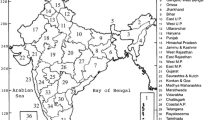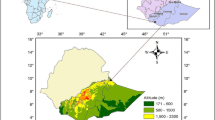Abstract
The present study explores the properties of precipitating shallow echoes (PSEs) over the tropical areas (30°S–30°N) during Indian summer monsoon season using attenuated corrected radar reflectivity factor (Ze) measured by the Tropical Rainfall Measuring Mission satellite. Radar echoes observed in study are less than the freezing height, so they belong to warm precipitation. Radar echoes with at least 0.75 km wide are considered for finding the shallow echoes climatology. Western Ghats and adjoining ocean (Arabian sea) have the highest PSEs followed by Myanmar and Burma coast, whereas the overall west coast of Latin America consists of the lowest PSEs. Tropical oceanic areas contain fewer PSEs compared to coastal areas. Average vertical profiles show nearly similar Ze characteristics which peaks between 1.5 and 2 km altitude with model value 32–34 dBZ. Slope of Ze is higher for intense PSEs as radar reflectivity decreases more rapidly in intense PSEs.







Similar content being viewed by others
References
Alcala C, Dessler A (2002) Observations of deep convection in the tropics using the tropical rainfall measuring mission (TRMM) precipitation radar. J Geophys Res 107:D244792. doi:10.1029/2002JD002457
Austin G, Rauber R, Ochs H III, Miller L (1996) Trade-wind clouds and Hawaiian rainbands. Mon Weather Rev 124:2126–2151
Berg W, L'Ecuyer T, Kummerow C (2006) Rainfall climate regimes: the relationship of regional TRMM rainfall biases to the environment. J Appl Meteorol Climatol 45(3):434–454
Beard K, Pruppacher HR (1969) A determination of the terminal velocity and drag of small water drops by means of a wind tunnel. J Atmos Sci 26(5):1066–1072
Bhat GS, Kumar S (2015) Vertical structure of cumulonimbus towers and intense convective clouds over the South Asian region during the summer monsoon season. J Geophys Res Atmos 120:1710–1722. doi:10.1002/2014JD022552
Byers H, Hall R (1955) A census of cumulus cloud height versus precipitation in the vicinity of Puerto Rico during the winter and spring of 1953–1954. J Meteorol 12:176–178
Colon R, Rauber MR, Jensen J (2006) Influence of low-level wind speed on droplet spectra near cloud base in trade wind cumulus. Geophys Res Lett 33:L20814. doi:10.1029/2006GL027487
Dee DP et al (2011) The ERA-interim reanalysis: configuration and performance of the data assimilation system. Q J R Meteorol Soc 137:553–597
Fabry F, Zawadzki I (1995) Long-term radar observations of the melting layer of precipitation and their interpretation. J Atmos Sci 52:838–851
Heymsfield GM, Tian L, Heymsfield AJ, Li L, Guimond S (2010) Characteristics of deep tropical and subtropical convection from nadir-viewing high-altitude airborne Doppler radar. J Atmos Sci 67:285–308
Hirose M, Nakamura K (2004) Spatio-temporal variation of the vertical gradient of rainfall rate observed by the TRMM precipitation radar. J Clim 17(17):3378–3397
Houze RA Jr, Wilton DC, Smull FB (2007) Monsoon convection in the Himalayan region as seen by the TRMM precipitation radar. Q J R Meteorol Soc 133:1389–1411
Houze RA (1993) Cloud dynamics. Academic Press Inc, San Diego
Hudson J, Mishra S (2007) Relationships between CCN and cloud microphysics variations in clean maritime air. Geophys Res Lett 34:L16804. doi:10.1029/2007GL030044
Johnson RH, Rickenbach TM, Rutledge SA, Ciesielski PE, Schubert WH (1999) Trimodal characteristics of tropical convection. J Clim 12:2397–2418
Konwar M, Maheskumar RS, Kulkarni JR, Freud E, Goswami BN, Rosenfeld D (2012) Aerosol control on depth of warm rain in convective clouds. J Geophys Res Atmos 117(D13). doi:10.1029/2012JD017585
Konwar M, Das SK, Deshpande SM, Chakravarty K, Goswami BN (2014) Microphysics of clouds and rain over the western Ghat. J Geophys Res Atmos 119:6140–6159. doi:10.1002/2014JD021606
Kubar TL, Hartmann DL (2008) Vertical structure of tropical oceanic convective clouds and its relation to precipitation. Geophys Res Lett 35:L03804. doi:10.1029/2007GL032811
Kumar S, Hazra A, Goswami BN (2013) Role of interaction between dynamics, thermodynamics and cloud microphysics on summer monsoon precipitating clouds over the Myanmar coast and the western Ghats. Clim Dyn. doi:10.1007/s00382-013-1909-3
Kumar S, Bhat GS (2016) Vertical profiles of radar reflectivity factor in intense convective clouds in the tropics. J Appl Meteorol Climatol 55(5):1277–1286. doi:10.1175/JAMC-D-15-0110.1
Kumar S (2015) A 10-year climatology of vertical properties of most active convective clouds over the Indian regions using TRMM PR. doi:10.1007/s00704-015-1641-5
Kumar S (2016) Three dimensional characteristics of precipitating cloud systems observed during Indian summer monsoon. Adv Space Res 58:1017–1032. doi:10.1016/j.asr.2016.05.052
Kumar S (2017) Vertical characteristics of reflectivity in intense convective clouds using TRMM PR data. Environ Nat Resour Res 7(2):58. doi:10.5539/enrr.v7n2p58
Kummerow C, Barnes W, Kozu T, Shiue J, Simpson J (1998) The tropical rainfall measuring mission (TRMM) sensor package. J Atmos Ocean Technol 15:809–817
Lau KM, Wu HT (2003) Warm rain processes over tropical oceans and climate implications. Geophys Res Lett 30(24):2290. doi:10.1029/ 2003GL018567
LeMone MA, Meitin RJ (1984) Three examples of fair- weather mesoscale boundary layer convection in the Tropics. Mon Weather Rev 112:1985–1997
Liu C, Zipser EJ (2013) Why does radar reflectivity tend to increase downward toward the ocean surface, but decrease downward toward the land surface? J Geophys Res Atmos 118:135–148. doi:10.1029/2012JD018134
Liu C, Zipser ED, Nesbitt SW (2007) Global distribution of tropical deep convection: different perspectives from TRMM infrared and radar data. J Clim 20:489–503
Liu C, Zipser ED, Cecil SW, Nesbitt SW, Sherwood S (2008) A cloud and precipitation feature database from nine years of TRMM observations. J Appl Meteorol Climatol 47(10):2712–2728
Liu C, Cecil DJ, Zipser EJ, Kronfeld K, Robertson R (2012) Relationships between lightning flash rates and radar reflectivity vertical structures in thunderstorms over the tropics and subtropics. J Geophys Res 117:D06212. doi:10.1029/2011JD017123
Masunaga H, Kummerow CD (2006) Observations of tropical precipitating clouds ranging from shallow to deep convective systems. Geophys Res Let 33:L16805. doi:10.1029/2006GL026547
Maheskumar RS, Narkhedkar SG, Morwal SB, Padmakumari B, Kothawale DR, Joshi RR, Deshpande CG, Bhalwankar RV, Kulkarni JR (2014) Mechanism of high rainfall over the Indian west coast region during the monsoon season. Clim Dyn 43(5–6):1513–1529
Nesbitt SW, Zipser E, Cecil C (2000) A census of precipitation features in the tropics using TRMM radar, ice scattering, and lightning observations. J Clim 13:4087–4106
Nesbitt SW, Cifelli R, Rutledge A (2006) Storm morphology and rainfall characteristics of TRMM precipitation features. Mon Weather Rev 134:2702–2721
Nuijens L, Stevens B, Siebesma AP (2009) The environment of precipitating shallow cumulus convection. J Atmos Sci 66:1962–1979
Petersen WA, Rutledge SA (2001) Regional variability in tropical convection: observation from TRMM. J Clim 13:4087–4106
Petty G (1999) Prevalence of precipitation from warm-topped cumulus clouds over eastern Asia and the western Pacific. J Clim 12:220–229
Qie XS, Wu XK, Yuan T, Bian JC, Lu DR (2014) Comprehensive pattern of deep convective systems over the Tibetan plateau-south Asian monsoon region based on TRMM data. J Clim 27:6612–6626. doi:10.1175/JCLI-D-14-00076.1
Rao YP (1976) Southwest monsoon, India meteorological department (available at http://www.imd.gov.in/section/nhac/dynamic/Monsoon_frame.htm)
Romatschke U, Houze RA Jr (2011a) Characteristics of precipitating convective systems in the premonsoon season of South Asia. J Hydrometeorol 12:3–26. doi:10.1175/2010JHM1289
Romatschke U, Houze RA Jr (2011b) Characteristics of precipitating convective systems in the south Asian monsoon. J Hydrometeorol 12:157–180. doi:10.1175/2010JHM1311.1
Romatschke U, Medina S, Houze RA Jr (2010) Regional, seasonal, and diurnal variations of extreme convection in south Asian region. J Clim 23:419–439
Rossow WB, Schiffer RA (1991) ISCCP cloud data products. Bull Am Meteorol Soc 72:2–20
Saikranthi K, Rao TN, Radhakrishna B, Rao SVB (2014) Morphology of the vertical structure of precipitation over India and adjoining oceans based on long-term measurements of TRMM PR. J Geophys Res Atmos 119:8433–8449. doi:10.1002/2014JD021774
Schumacher C, Houze R Jr (2003) The TRMM precipitation radar’s view of shallow, isolated rain. J Appl Meteorol 42:1519–1524
Schumacher C (2006) Shallow tropical convection: how often does it rain? Bull Am Meteorol Soc 87:23–25
Shrestha D, Deshar R, Nakamura K (2015) Characteristics of summer precipitation around the Western Ghats and the Myanmar West Coast. Int J Atmos Sci 206016. doi:10.1155/2015/20601
Short D, Nakamura K (2000) TRMM radar observations of shallow precipitation over the tropical oceans. J Clim 13:4107–4124
Ulbrich CW, Atlas D (1998) Rainfall microphysics and radar properties: analysis methods for drop size spectra. J Appl Meteorol 37:912–923
Waliser DE, Graham NE (1993) Convective cloud systems and warm-pool sea surface temperatures’ coupled interactions and self-regulation. J Geophys Res 98:D7 12881–D7 12893
Wu Z (2003) A shallow CISK, deep equilibrium mechanism for the interaction between large-scale convection and large- scale circulation in the tropics. J Atmos Sci 60:377–392
Xu W, Zipser EJ (2012) Properties of deep convection in tropical continental, monsoon, and oceanic rainfall regimes. Geophys Res Lett 39:L07802. doi:10.1029/2012GL051242
Yuan T, Qie X (2008) Study on lightning activity and precipitation characteristics before and after the onset of the South China Sea summer monsoon. J Geophys Res 113:D14101. doi:10.1029/2007JD009382
Yuter SE, Houze Jr RA (1995) Three-dimensional kinematic and microphysical evolution of Florida cumulonimbus: Part II. Frequency distribution of vertical velocity, reflectivity, and the differential reflectivity. Mon Weather Rev 123:1941–1963
Zipser EJ, Cecil DJ, Liu C, Nesbitt SW, Yorty DP (2006) Where are the most intense thunderstorms on earth? Bull Am Meteorol Soc 87:1057–1071
Author information
Authors and Affiliations
Corresponding author
Electronic supplementary material
Supplementary Fig. 1
(DOCX 41 kb)
Supplementary Fig. 2
(DOCX 240 kb)
Rights and permissions
About this article
Cite this article
Kumar, S. Vertical structure of precipitating shallow echoes observed from TRMM during Indian summer monsoon. Theor Appl Climatol 133, 1051–1059 (2018). https://doi.org/10.1007/s00704-017-2238-y
Received:
Accepted:
Published:
Issue Date:
DOI: https://doi.org/10.1007/s00704-017-2238-y




